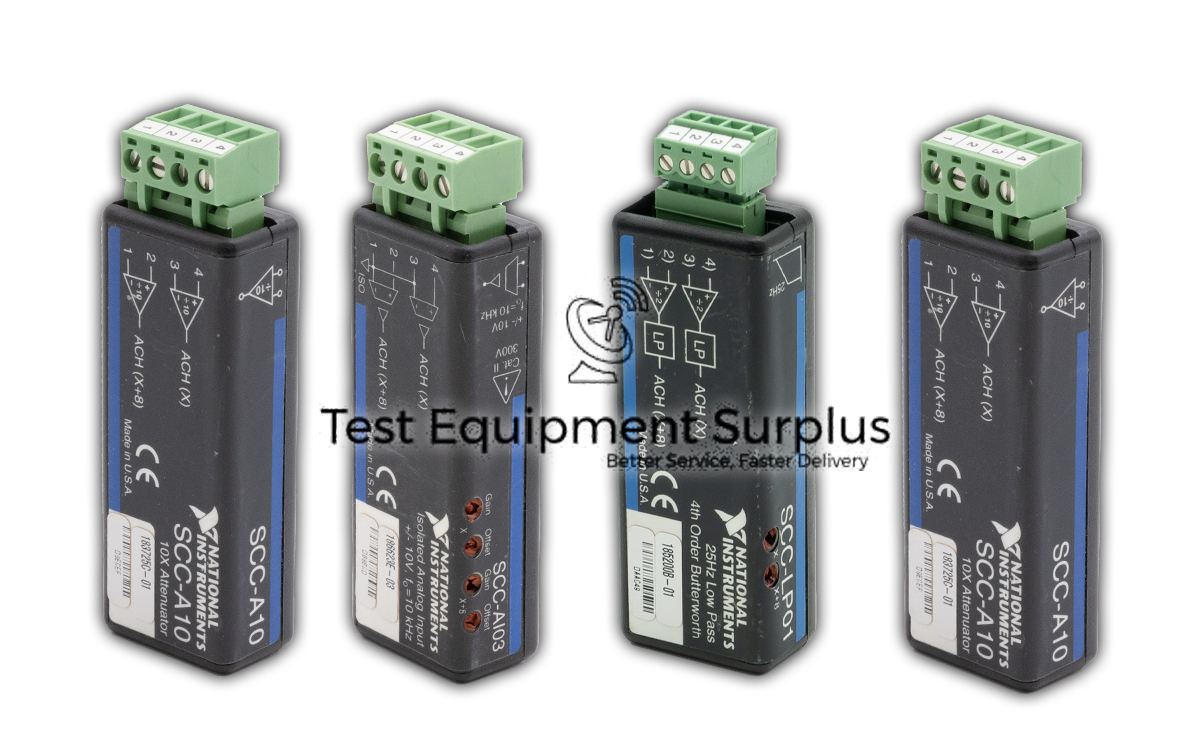Description
The SCC-A10 Voltage Attenuator Module, with Part Number 777459-06, is a high-quality product from National Instruments designed to attenuate input voltages by a factor of 10. It is equipped with two differential instrumentation buffer input channels capable of handling an input voltage range of ± 60 VDC and offers an input impedance of 1 Mega Ohm.
This module supports a bandwidth of 10 kHz and ensures a minimum common-mode rejection ratio of 60 dB. It operates on an analog power requirement of 100 mW max, with a maximum current draw of 3.2 mA at +15 V and -15 V, while the digital power requirement is 0.0 mA.
For compatibility, it works seamlessly with hardware such as SCC-68, SC-2345/2350, and 68-pin E/M Series DAQ devices. The SCC-A10’s dynamic response capabilities are enhanced by its support for E/M Series DAQ.
Furthermore, this module comes with an essential overvoltage protection feature capable of handling up to 60 VDC, ensuring the safety of your DAQ systems. It includes a 20-pin right-angle male connector and a 4-pin screw terminal for secure connections.
| Specification | Details |
|---|---|
| Part Number | 777459-06 |
| Product Name | SCC-A10 Voltage Attenuator Module |
| Manufacturer | National Instruments |
| Attenuation Factor | 10 |
| Input Channels | 2 Differential Instrumentation Buffer |
| Input Voltage Range | ± 60 VDC |
| Input Impedance | 1 Mega Ohm |
| Bandwidth | 10 kHz |
| Common-Mode Rejection Ratio (Min) | 60 dB |
| Analog Power Requirement | 100 mW max, 3.2 mA max at +15 V and -15 V |
| Digital Power Requirement | 0.0 mA |
| Compatible Hardware | SCC-68, SC-2345/2350, 68-pin E/M Series DAQ Device |
| Dynamic Response Capabilities | Supports E/M Series DAQ |
| Overvoltage Protection | Up to 60 VDC |
| Connectors | One 20-pin right-angle male connector, One 4-pin |
Question 1: What input impedance value does the SCC-A10 Voltage Attenuator Module from National Instruments offer for its two differential instrumentation buffer input channels?
Answer 1: The SCC-A10 Voltage Attenuator Module from National Instruments offers an input impedance of 1 Mega Ohm for its two differential instrumentation buffer input channels.
Question 2: What is the maximum input voltage range and bandwidth supported by the SCC-A10 Voltage Attenuator Module from National Instruments, and with which hardware devices is it compatible?
Answer 2: The input impedance of the SCC-A10 Voltage Attenuator Module from National Instruments with Part Number 777459-06 is 1 Mega Ohm, and it offers a minimum common-mode rejection ratio of 60 dB.
Question 3: What is the input impedance and common-mode rejection ratio of the SCC-A10 Voltage Attenuator Module from National Instruments with Part Number 777459-06?
Answer 3: The SCC-A10 Voltage Attenuator Module from National Instruments supports a maximum input voltage range of ±60 VDC and a bandwidth of 10 kHz, and it is compatible with hardware devices such as SCC-68, SC-2345/2350, and 68-pin E/M Series DAQ devices.
Question 4: What input voltage range and impedance are supported by the SCC-A10 Voltage Attenuator Module from National Instruments, and what types of hardware is it compatible with?
Answer 4: The SCC-A10 Voltage Attenuator Module from National Instruments with Part Number 777459-06 has an input impedance of 1 Mega Ohm and a common-mode rejection ratio of at least 60 dB.
Question 5: What are the input impedance and common-mode rejection ratio specifications for the SCC-A10 Voltage Attenuator Module from National Instruments with Part Number 777459-06?
Answer 5: The SCC-A10 Voltage Attenuator Module from National Instruments supports an input voltage range of ± 60 VDC and an input impedance of 1 Mega Ohm, and it is compatible with hardware such as SCC-68, SC-2345/2350, and 68-pin E/M Series DAQ devices.


